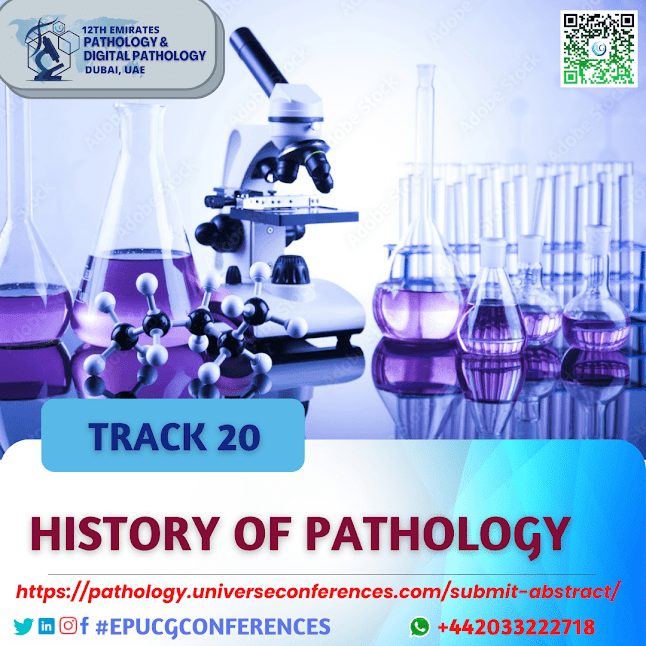How to Improve the Digital Pathology Imaging Factor
The introduction of whole-slide digital imaging technologies has sparked the development of novel interactive pathology education models, accelerated clinical processes, and allowed for the development of new medically actionable image analysis tools and investigative methodologies. This technology has supplied the clinical and scientific community with new solutions that will need to be integrated with established models for modern care, despite the fact that it is still evolving. Finally, we expect a new system of care to evolve, in which these breakthrough technologies are rationally and thoroughly validated and integrated into everyday practise. The high-tech world of digital pathology imaging is beset by a low-tech issue. And getting the more knowledge about of improving the factor of digital pathology join us at CME/CPD accredited 11th Emirates Pathology & Digital Pathology Conference on May 09-10, 2022, Online & enhance your knowledge on Pathology
The issue: Due to the fact that digital pathology is
advancing rapidly around the world, with more clinicians examining tissue
images on "smart" computers to diagnose patients, there are no
trustworthy guidelines for the processing and digitalization of tissue slides.
This means that low-quality slides are mixed in with
high-quality slides, possibly confusing or misleading a computer algorithm
attempting to learn how to recognize a malignant cell, Case Western Reserve
University researchers are working to change that
The two have a three-year, $1.2 million grant from the
National Cancer Institute to fund their new quality-control tool, which was
just published in the Journal of Clinical Oncology Clinical Informatics.
The new system uses a set of metrics and classifiers to help
users identify corrupted photographs and keep those that would help technicians
and physicians diagnose problems.
Access to the right information is key when making Digital
pathology, Join us CME/CPD accredited 11th Emirates Pathology
& Digital Pathology Utilitarian Conference, Which is scheduled to held May 9-10, 2022, Online
Avail Certifications. Register here: https://pathology.universeconferences.com/registration/
Image analysis with computer systems
imaging physicists, to explore the potential of a newly
established branch in the field of pathology, Pathologists have been
collaborating with technology experts, such as data scientists, computational
engineers,: machine vision, a component of computational image analysis,
thanks to advances in scanning technology and the increasing availability of
large datasets of digital images. The main goal of this field is to extract
and/or produce quantitative data from digital image subject matter, either
alone or in conjunction with other types of spatially or non-spatially based
biological or omics data. Recognizing the data provided by computational image
analysis has a high degree of dimensionality
Don't miss the opportunity hurry up submit your paper at
CME/CPD accredited 11th Emirates
Pathology & Digital Pathology Utilitarian Conference, Which is
scheduled to held May 9-10, 2022, Online
Submit your abstract here: https://pathology.universeconferences.com/submit-abstract/
AI models, such as ML and DL, can be utilised for a variety
of tasks, including illness diagnosis and automatic detection, segmentation,
and quantification of histological parameters and structural alterations. These
are referred to as 'low-level' activities. In contrast, in 'high-level tasks,'
AI models are used to simultaneously interrogate and integrate multiple classes
of primary data — for example, histopathological image data spatially coupled
to transcriptomic data — allowing for the prediction of processes such as
disease aggression (for example, the biological potential of a malignancy),
patient outcome, organ engraftment survival, and therapeutic response. As a
result, AI has the ability to raise digital images from their fundamental duty
as a tool for visual assessment of illness condition to a far more complicated
and comprehensive position as a tool for disease trajectory prediction. In the context
of direct human cognitive and visual assessment, these new capabilities enable
the extraction of meaningful information in a way that was previously not
conceivable with conventional microscopy.
Pathology is more common in pathology than in other areas of
medicine. Aside from research, the route to completely digitised clinical
pathology departments with whole slide imaging (WSI), convolutional neural
networks (CNNs), and cost-effective, high-performance processing and data
storage is still a work in progress. The technology is still in its infancy,
best practises for AI differ, and data difficulties can be a stumbling barrier.
The process of creating high-resolution digital images from
tissue sections on glass slides is known as digital pathology (also
known as telepathology or whole slide imaging). A pathologist examines these
glass slides under a microscope as part of the diagnosis process. Pathologists
can now operate remotely and interact with other experts when second opinions
are needed, thanks to the advent of digital pathology, which stores digital
pictures on secure servers and allows them to be viewed on computer monitors.
There are numerous advantages to incorporating digital pathology into clinical
practise. Despite the fact that this has long been recognised, its use as a
diagnostic tool is still limited, and pathologists' estimates for its future
use are cautious
Oral Pathology Conferences, Pathology Conferences, Pathology meetings, Pathology Utilitarian Conferences, Pathology webinar 2020, Pathology Medical Conferences, Histopathology
meeting, Immunology conference, clinical Pathology webinars, Plant Pathology Conferences, CME Pathology Conferences, Pathology Congresses, World Pathology Congress, Clinical Pathology, Laboratory Medicine Conference, Digital Pathology exhibition
Visit our website for the upcoming pathology
and digital pathology conference 2022 for more details.
Reach out to us: https://pathology.universeconferences.com/
Mail: pathology@universeconferences.com
| info@utilitarianconferences.com
WhatsApp: +442033222718
Call: +12076890407
Reference pathology and digital pathology
UCGconferences press releases and blogs
Linked In: https://www.linkedin.com/pulse/digital-pathology-advantages-limitations-emerging-dr-travis-stork
Blogger: https://emiratespathologyucgconferences.blogspot.com/2022/03/digital-pathology-advantages.html
#UCGmeeting #ComputationalPathology
#computationalbiology #computationalchemistry #computational
#computationalimaging #clinicalresearch #medicalstudent #medicaleducation
#COvid #omicron #bpath #meeting #Online #UCGConferences #MolecularPathology
#SLPath #pathologist #surgery #microbiology #anatomy #biochemistry #anatomy
#medstudent #medstudent #pathologists #histology #medicine #pharmacology
#medschool #biology #medico #dermpath #microscope #clinicalresearch #medicalstudent
#medicaleducation #Covid19 #omicron #bpath #meeting
.png)
.png)




Comments
Post a Comment